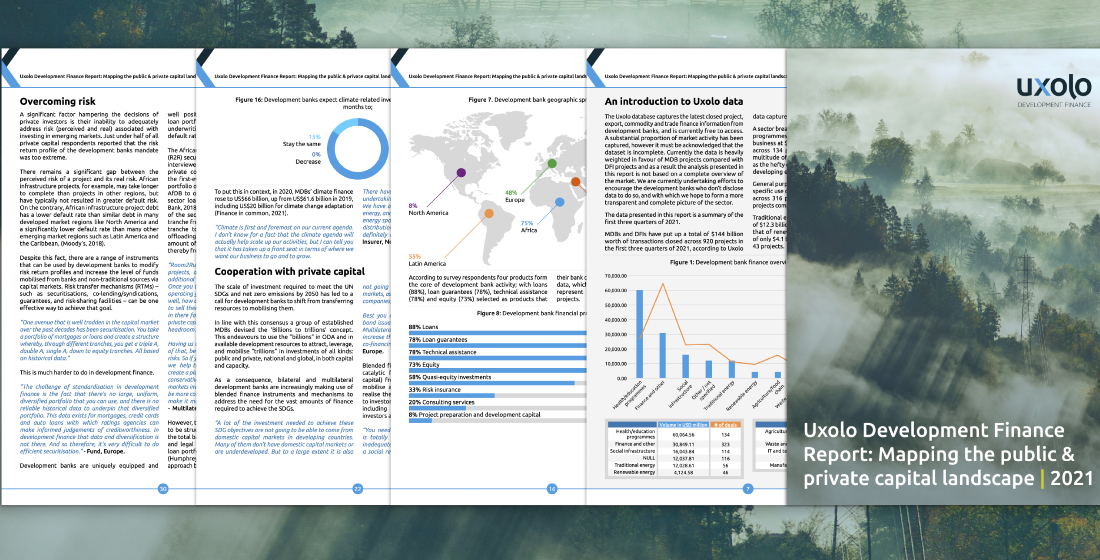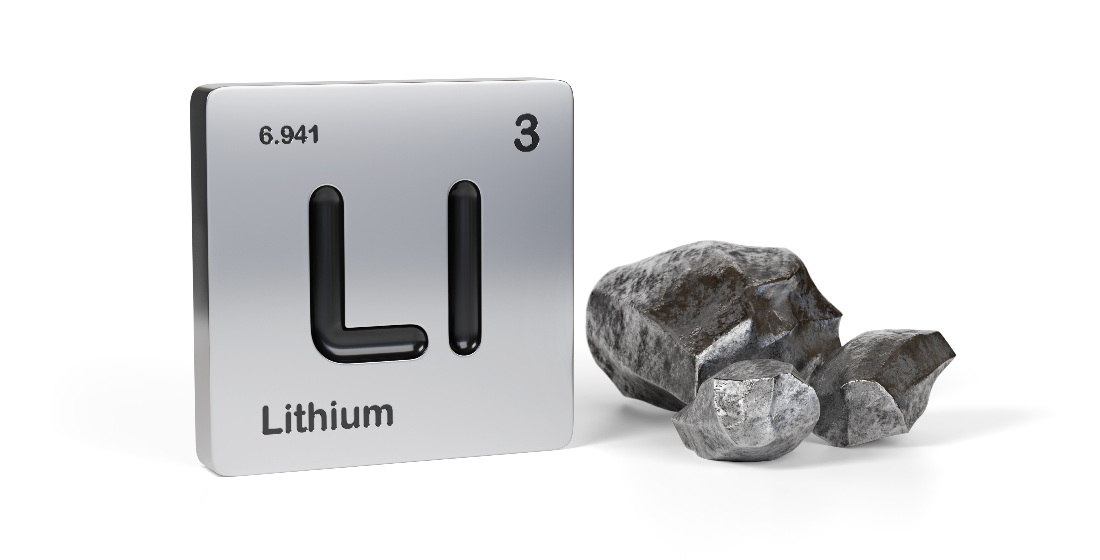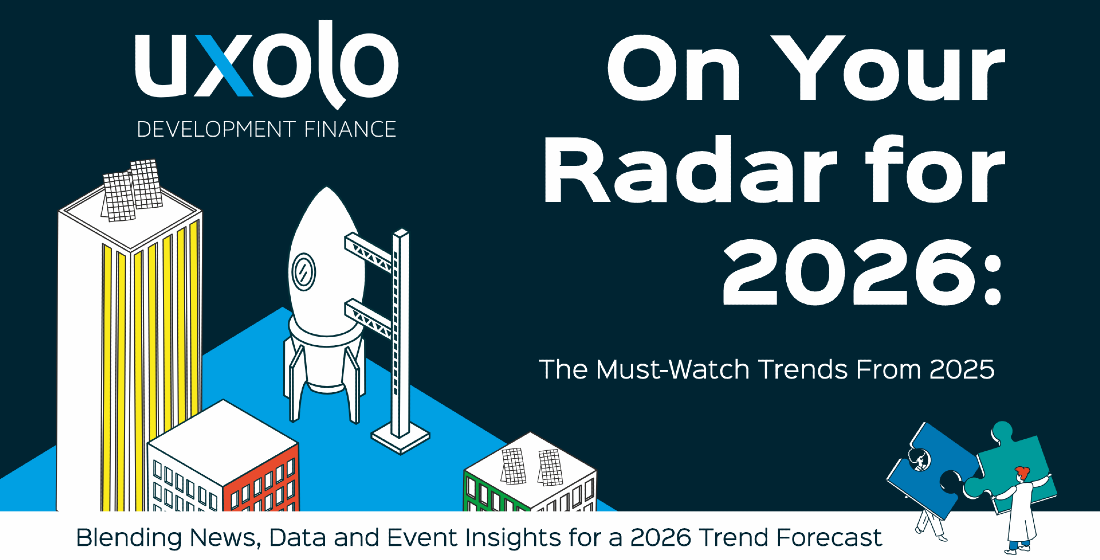Uxolo Development Finance Report: Top five takeaways
By combining our inhouse project database, survey results and interviews, Uxolo’s Develpment Finance Report provides the most comprehensive landscape to date of what development banks are doing and where, including their interactions with private capital.

Development banks have a clear mandate: to support developing economies by deploying funds to projects which encourage economic development and address market failures while simultaneously providing comfort and expertise to the local ecosystem of banks. In recent years the UN’s 17 Sustainable Development Goals (SDG’s) has become the blueprint from which development finance has been designed and deployed.
With estimates that combined investments of development banks reached $2.2 trillion in 2019, or about 10% of total global investments, forming an accurate and coherent picture of who’s doing what is no simple task.
Uxolo’s inaugural research report – Uxolo Development Finance Report: Mapping the public & private capital landscape – aims to paint this picture. Crucially, the report does not focus on what has been promised or pledged, but on what has been and is being done.
Who’s represented?
A total of 64 respondents took part in the survey, with just over two-thirds of the total sample identifying as development banks. The remaining respondents identified themselves as private capital providers. In total 19 individual development banks are represented, of which roughly two-thirds are MDB’s. Participant private capital institutions include impact investors, banks, private equity funds and asset managers to name a few.
Africa as the locus of activity
Unsurprisingly, continents with high numbers of low and lower-middle-income nations are a priority for development banks, with 75% of all development banks who completed the survey reported operating in Africa, making the continent the top destination for development capital. Indeed, according to Uxolo data included in the report Africa attracted the greatest capital at $64 billion, representing 45% of the total volume deployed in the first three quarters of 2021 by all development banks.
When asked how they’re capital is predominantly deployed, development banks identified four products that form the core of their activity - loans, loan guarantees, technical assistance and equity. When cross referenced with Uxolo data, direct Sovereign loans to African nations can be said to form the bulk of development bank activity. Uxolo data shows that sovereigns represent the lion’s share of development bank capital spending, totaling $108 billion.
Covid-19 has put the SDG’s further out of reach
Throughout the Covid-19 pandemic, development banks and their countercyclical activities have played a critical role in supporting lower middle and low income countries across the developing world. However, Covid-19 has decimated tax revenues in developing economies, inflated debt burdens and, as a consequence, interest payments, making it even harder for these nations to finance progress towards the UN’s SDGs.
Headline estimates of the cost of meeting the SDGs range widely. But importantly, all the estimates suggest a significant gap vs. current funding – a gap that burgeoned in the wake of the pandemic. Original UN estimates put a price tag on the SDGs of $5-$7 billion annually, with a $2.5 trillion shortfall. More recent calculations have upped the cost to $3.7 trillion and some estimates have the gap as high as $8-$10 trillion according to a 2021 report by The Force for Good Initiative.
Development banks are natural allies of the 2030 Agenda, however it’s clear that, whether unable or unwilling, development banks simply aren’t able to meet the colossal price tag of the 17 SDGs alone.
Development banks are making the shift from transferring resources to mobilising them
The prevailing wisdom has become that actors in development finance and private capital need to collaborate to bridge the trillion dollar funding gap. Given the finance industry’s role as the allocator of the vast majority of the world’s wealth, and its traditional role as a facilitator of growth and development it has a vital role to play in realising the SDGs.
Development banks reported being willing and eager to cooperate with private capital in ‘blended finance’ transactions and initiatives. Indeed 68% of bilateral and multilateral development banks reported that they had accessed private capital in 2020, cooperating predominantly with banks, private equity funds and impact investment funds.
Over two thirds of MDBs invested over $750 million alongside a private capital provider in 2020, for DFIs this figure is 9%. MDBs usually have a greater financing capacity than DFIs and it is therefore no surprise to see them report greater volumes.
Private capital is seeking are seeking a middle ground between impact and returns
Win-win projects that efficiently decarbonise the economy, benefit the poor and generate healthy financial returns are no easy feat to realise. Even with trillions of dollars of investments being committed in the wake of COP26 to renewable energy projects, these schemes still need to be commercially viable to be deemed bankable by MDBs and international banks.
The balance between returns and positive impact can be seen in the sector’s private capital respondents’ report as those they have co-invested in alongside development banks. Of those that had partnered with a development bank, 65% have co-invested in infrastructure and renewables, followed by agri/soft commodities (47%) and transport (47%). Despite the potential for returns in these sectors, only 6% were invested in chemicals/petrochemicals, metals & mining and oil & gas alongside development banks.
This indicates that private capital providers with development objectives are navigating a middle ground between ‘dirty’ industries like oil & gas and high impact health and education sectors. Renewables, infrastructure and power are the go-to sectors, or in other words the sectors private capital feels a comfortable balance between impact and returns.
Working with development banks poses some fundamental challenges
Overall, private capital providers indicated that working with development banks posed a moderate challenge. The time it takes to close a deal was presented as the biggest impediment, with 83% of the sample highlighting this as a main challenge. Development banks having too many criteria or requirements (61%) and extreme risk return profiles (44%) also ranked as some of the main challenges from a private capital perspective.
But mixing and matching multiple stakeholders – typically development banks, export credit agencies (ECAs), charities, impact investors and commercial lenders – with different objectives and goals is key to blended finance, and continues to pose a significant plumbing issue. Bringing them together and finding the optimal structure for financing projects is a major hurdle, particularly with regard to the allocation of risk and return among the various financiers and their respective objectives.
Despite these challenges, it seems apparent that private capital has not lost its appetite for blended finance, indeed almost all private capital respondents (94%) said they intend to work with development banks in the future.
To read the full report, please click here.




